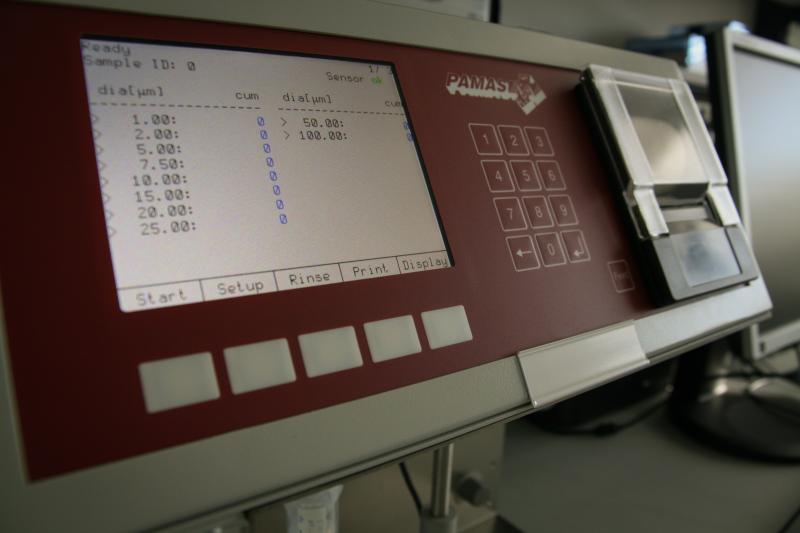Light Obscuration (LO)
Compendial Analysis of Subvisible Particles in Parenteral and Ophthalmic Products
Light obscuration (LO) is listed in the pharmacopoeias Ph. Eur. 2.9.19, USP <788>, USP <787> and USP<789>. During measurement, the sample is drawn into the system through a needle and particles passing a laser beam block a certain amount of light and produce a “shadow” on a light-sensitive detector. The area of this shadow is then converted to an equivalent circular diameter of the particle, based on a calibration curve generated with polystyrene standard beads.

LO allows counting and sizing of subvisible particles in the size range from about 1 to 200 µm. The upper particle concentration limit is system dependent and usually about 10^5 and 10^6 particles/mL. The pharmacopoeias give specifications for particles >10 µm (less than 6,000 particles per container for low-volume parenterals of 100 mL or less) and particles >25 µm (less than 600 particles per container for low-volume parenterals of 100 mL or less). However, the quantification of smaller subvisible particles (>1 µm) is nowadays also expected by the regulatory authorities. At Coriolis, we have already many years of experience in using low volume methods for LO analysis of numerous different biopharmaceutical products (see our publication “Pharmaceutical feasibility of sub-visible particle analysis in parenterals with reduced volume light obscuration methods").
The LO technique is used during all stages of development, from early research to batch release testing for the quantification of subvisible particles. At Coriolis, LO can be offered in full GMP compliance.
Quality & Biosafety Level
We provide all our analytical services with the highest quality standards. Each project is carried out by experienced scientists and every report or data presentation is comprehensively checked by a scientific reviewer. We offer this technology with the following quality and biosafety level:
Advantages
Main advantages of Light Obscuration are the high sampling efficiency, as the whole sample volume can be analyzed during the measurement, and the short measurement and data handling times. However, the presence of air bubbles and the formation of Schlieren patterns can result in erroneously high particle levels in LO measurements. But, a well-established sample preparation procedure can avoid these issues. Like all light-based techniques, LO depends on a difference in refractive index between particle and solvent. The validity of LO results should thus be validated by using orthogonal methods.
Standardized Methods or Dedicated Method Development
For common sample types, we can often apply standardized methods with little setup effort. On top of this, our experienced analytical scientists perform in-depth method development or method optimization tailored to your drug substance, product type and development phase. Under GMP, we also offer full method validation or compendial method verification.
Method development
During method development, we tailor sample preparation, method settings, and data analysis to the needs of your project and sample.
For this purpose, we include a representative sample and, where available, suitable reference standards and stressed/degraded materials. This way, our analytical scientists can design a method that is highly suitable for your needs, stability indicating, as well as robust and repeatable. Upon request, we compile a detailed method description for your records.
This can be applied under R&D and GMP. Read more
Method qualification
A method qualification is the initial assessment of the performance of an analytical procedure to show that it is suitable for the intended purpose.
During method qualification, our analytical scientists perform a documented testing that demonstrates that the analytical procedure meets certain acceptance criteria in several categories. These may include repeatability, linearity, intermediate precision, robustness and more. We compile a qualification plan and a qualification report including all relevant data.
This can be applied under R&D and GMP. Read more
Method validation
A method validation is the confirmation under highly controlled conditions that the performance of an analytical procedure is suitable for the intended purpose.
During method validation, our analytical scientists perform a documented testing, which demonstrates that the analytical procedure consistently produces a result that meets the pre-determined acceptance criteria. We compile a validation plan and a validation report including all relevant data.
This can be applied under GMP. Read more
Contact us
Contact us
Do you have any questions? Please contact Dr. Jörg Müller!
Phone: +49 89 41 77 60 – 111
Mail: joerg.mueller@coriolis-pharma.com


